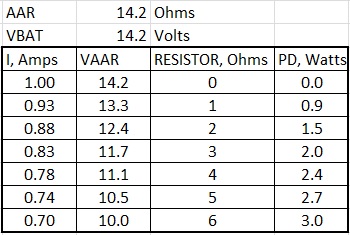|
|

|
Porsche, and the Porsche crest are registered trademarks of Dr. Ing. h.c. F. Porsche AG.
This site is not affiliated with Porsche in any way. Its only purpose is to provide an online forum for car enthusiasts. All other trademarks are property of their respective owners. |
|
|
| jsayre914 |
 Aug 19 2013, 05:07 PM Aug 19 2013, 05:07 PM
Post
#1
|
|
Speed Up !!!     Group: Members Posts: 3,188 Joined: 10-February 08 From: Timonium MD 21093 Member No.: 8,696 Region Association: MidAtlantic Region |
I was reading the D-Jet Brad Anders and came across the part about the aux air regulator. I will quote from his site:
Does Yours Close Too Fast?: If you'd like for the AAR to stay open longer, try adding 2.5 ohms (four 10 ohm/10W power resistors in parallel) in series with the heater. This will reduce the heater power from ~14W down to ~10W, and cause the AAR to close more slowly. Should add a few minutes to the fast idle part of the cycle. Please exercise caution - that resistor pack can get hot, make sure it is safely secured. My 2056 runs pretty rich on cold start, the aux air valve is working as it should, I tested it 14.2ohms and put it in the freezer, it opened all the way, then put it in a ziplock and submerged it in boiling water and it closed all the way. I noticed that the idle drops pretty quick, like within 2min it is below 1000rpm. I was going to try to slow down the aar closing so i could get a good 5min or so before it drops. I tried to just unplug it because the valve will close by itself with just the heat from the engine. This kept the idle up for more much more than 5 min. So teach me how to drop the voltage from 14.4 to about 10v I dont want to melt anything, start a fire, or screw with the same circuit the fuel pump is running on. What do i buy, where do I buy it and what do I have to do to make my idea work. (IMG:style_emoticons/default/popcorn[1].gif) I have an 250ohm resistor in the garage from a 2.0 liter cht sender that would fit perfect in line, would that work (IMG:style_emoticons/default/rolleyes.gif) (IMG:style_emoticons/default/beer3.gif) |
  |
Replies
| Spoke |
 Aug 23 2013, 09:56 PM Aug 23 2013, 09:56 PM
Post
#2
|
|
Jerry      Group: Members Posts: 6,986 Joined: 29-October 04 From: Allentown, PA Member No.: 3,031 Region Association: None 
|
So teach me how to drop the voltage from 14.4 to about 10v Very easy to drop the AAR voltage as Brad and other have said. The AAR is a resistor of 14.2 ohms. So add a resistor in the circuit to drop voltage: 14V ------ RESISTOR ------- AAR ------GND Resistors in series share the total voltage such that the amount of voltage across each resistor is proportional to the resistance divided by the total resistance in the circuit. Thus, AAR voltage is: V-AAR = 14.2V x AAR/(RESISTOR + AAR) The current is voltage divided by total resistance: I = 14.2V/(RESISTOR + AAR) We need to know the current to calculate the power dissipation in the resistor. Power dissipation in the resistor is I x I x R. Let's let RESISTOR be 0, 1, 2, 3, 4, 5, 6 ohms and plug into above formulas. Let battery voltage be 14.2V. You can see below that 6 ohms will drop voltage and provide 10V across the AAR. This will slow down the opening. Wattage of the 6 ohm resistor is less than 3W. Best to find a resistor that is 2x, 3x, or higher wattage like this 50W resistor from Digikey. It's in stock for about $5. 6 ohm, 50W Attached image(s) 
|
Posts in this topic
 jsayre914 Questions about resistors Aug 19 2013, 05:07 PM
jsayre914 Questions about resistors Aug 19 2013, 05:07 PM
 Dave_Darling 250 ohms is a whole lot more than 2.5 ohms. I sup... Aug 19 2013, 05:38 PM
Dave_Darling 250 ohms is a whole lot more than 2.5 ohms. I sup... Aug 19 2013, 05:38 PM
 kg6dxn Your 250ohm would most likely prevent it from work... Aug 19 2013, 07:36 PM
kg6dxn Your 250ohm would most likely prevent it from work... Aug 19 2013, 07:36 PM
 Tom Taking the values you have given, your current is ... Aug 20 2013, 08:27 AM
Tom Taking the values you have given, your current is ... Aug 20 2013, 08:27 AM
 worn
I was reading the D-Jet Brad Anders and came acro... Aug 20 2013, 11:17 AM
worn
I was reading the D-Jet Brad Anders and came acro... Aug 20 2013, 11:17 AM
 Racer Chris I'm working on a (csob diy) hand throttle kit ... Aug 20 2013, 12:36 PM
Racer Chris I'm working on a (csob diy) hand throttle kit ... Aug 20 2013, 12:36 PM

 jsayre914
I'm working on a (csob diy) hand throttle kit... Aug 20 2013, 03:23 PM
jsayre914
I'm working on a (csob diy) hand throttle kit... Aug 20 2013, 03:23 PM
 Racer Chris Mine will be more like the 914-6 hand throttle.
It... Aug 20 2013, 03:37 PM
Racer Chris Mine will be more like the 914-6 hand throttle.
It... Aug 20 2013, 03:37 PM
 jsayre914 Now I got another idea that might bring the same r... Aug 23 2013, 06:12 PM
jsayre914 Now I got another idea that might bring the same r... Aug 23 2013, 06:12 PM
 McMark It shouldn't be running rich. I think you... Aug 23 2013, 06:33 PM
McMark It shouldn't be running rich. I think you... Aug 23 2013, 06:33 PM  |
1 User(s) are reading this topic (1 Guests and 0 Anonymous Users)
0 Members:

|
Lo-Fi Version | Time is now: 29th May 2024 - 05:44 AM |
Invision Power Board
v9.1.4 © 2024 IPS, Inc.








